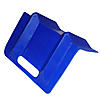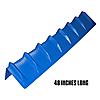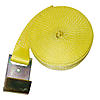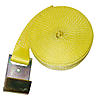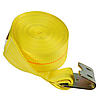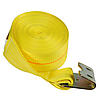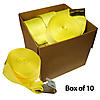Updated on 5/29/2024

In this blog post, we will discuss the best ways to help reduce costs and improve safety by using flatbed winch straps for cargo control securements. Learn how much money you can expect to save yearly compared to using alternative ratchet straps, the average number of tie-down straps flatbed operators go through every year, and some of the leading factors that cause straps to become damaged or fail. Let’s begin.

How Much Can You Expect To Save Using Winch Straps over Ratchet Straps Per Year?
At an average of 50 to 80 4-inch tie-down straps per year, this can quickly add up as the average 4-inch Ratchet Strap with Flat Hook is $35.00 to 40.00 dollars per strap at the time of writing this blog post. The average cost of the alternative 4-inch Winch Strap with Flat Hooks is $11.00 to 14.50 dollars per strap.
Both of these straps are made from the same tie-down webbing and metal end-fitting hardware but are tightened by two entirely different setups. This makes the average cost of replacing ratchet straps $24.00 to $25.50 more expensive per strap compared to purchasing 4-inch winch straps.
The cost difference is attributed to the heavy metal construction of the 4-inch ratchet hardware that is over 12 inches in length and weighs 8-9 lbs per ratchet hardware. This metal hardware is used to tighten the cargo into place and without the heavy ratchet, the cargo would not remain safely in place.
4-inch Winch Straps use the same webbing and hardware but are tightened into place using an installed flatbed winch that is installed along the rub rails on one side of the flatbed trailer. This helps to eliminate the need for heavy and bulky 4-inch ratchet hardware that can be quite expensive for purchasing entirely new straps.
If we take the savings on 50 straps as an average amount of straps used per year and the lower side of savings at $24.00 per strap difference we have a total of 1,200.00 dollars or more per year saved in using 4-inch Winch Straps over 4-inch Ratchet Straps.
The amount of dollars saved does not include the amount of money that may be required to install the winch track or the slider flatbed winches along the outside of the flatbed trailer but is a general amount of dollars you could expect to save while on the road every year. This helps save you money without the risk of jeopardizing the safety or the strength of your tie-down straps in the process.

How Many Winch Straps Do Flatbed Operators Go Through Every Year?
On average professional flatbed operators go through 50 to 80 pieces of 4-inch wide straps per year. This is mainly from the straps securing cargo that is much larger, much heavier duty construction, and securing around sharp metal edges that can either tear the webbing or cause friction burns which can cause the tie-down straps to weaken or become destroyed over time.
Once the straps have become damaged they are unsafe to use as they can no longer guarantee the safe working load limit or the breaking strength that the straps were rated for can be met. Tie-down straps can be damaged from anything from mold, mildew, direct sunlight, overloading, age, friction burns, or contact with sharp edges to name a few of the most common ways.
Once they have become damaged or labeled destroyed and unusable you will need to purchase new straps. If you have a ratchet strap that has become damaged you may be able to get away with purchasing either the long end or the short end of the ratchet strap with the ratchet hardware. This can quickly add up if you are going through 50 to 80 pieces per year to keep 20 straps on hand at all times.

The Most Common Ways That Winch Straps and Ratchet Straps Become Damaged
Overloading Your Straps – Exceeding the safe working load limit of your straps increases the risk of breakage due to extreme stress. It’s crucial to use an adequate number of tie-down straps to help evenly distribute the weight across various points on the cargo.
Avoiding Abrasion and Cuts – The most common way in which tie-down straps become damaged and result in the straps needing to be replaced is from the tie-down webbing becoming cut from sharp metal edges or the webbing becoming frayed. This causes the straps to become unsafe and unusable. One of the easiest ways to avoid this is by using corner protectors when possible and ensuring that you are not overtightening the tie-down straps when securing.
Ultraviolet Light Exposure from the Sun – As flatbed trailers do not have walls around the cargo like traditional dry van trailers that are enclosed they are exposed to direct sunlight while in use securing cargo. This ultraviolet light is harmful to your tie-down straps over time and may cause fading to the polyester tie-down straps or a changing of color to the webbing over time. During your routine inspections if you recognize that the straps have become faded from the original color you should further inspect the straps to determine if they need to be replaced or are unsafe to use.
The Age of the Tie-Down Strap – The age of the tie-down strap can cause the straps to become destroyed from being exposed to the elements for long periods as well as the general product lifespan. On average tie-down straps last somewhere around 3 to 5 years if they are well taken care of and stored in between uses for most 1-inch and 2-inch ratchet straps that are used for around-the-house securement.
With flatbed straps, the cargo control securement applications are much heavier, oversized, and more demanding and may only last upwards of several months if heavily used, stored correctly, and with the use of corner protectors to help protect the straps from sharp edges.
Improper Storage In-Between Usage – Tie-down straps will last vastly different lengths depending on how the straps are stored in between uses as Mold, Mildew, Direct Sunlight, and Friction Burns are some of the most common ways that straps become damaged. The one thing in common is that all of these ways that straps become damaged come directly from how they were stored in between uses.
For proper storage in-between uses, you will want to ensure that the straps are neatly organized and away from surfaces that can rub against each other going down the road as bumps, turns, or accelerations can cause the straps webbing to touch and cause friction burns. Also, the area you are storing the straps in should be away from direct sunlight and away from moisture and the ideal location for the straps should be inside the cab of the rig.
You can view our full blog post on How to Inspect Ratchet Straps for Damage and our blog post on How to Store Ratchet Straps Properly for further information on these topics.
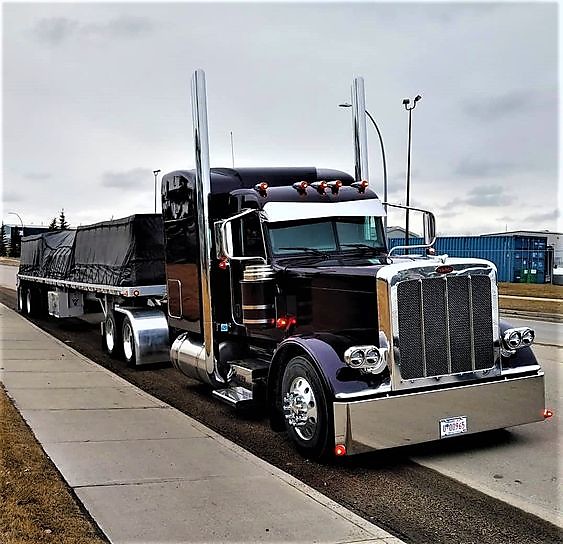
What Kind of Straps is Ideal for Securing Cargo on Flatbed Trailers?
Two main types of tie-down straps are commonly used on flatbed trailers with one of them being 4-inch flatbed winch straps and the other being 4-inch ratchet straps. Both of these straps are made from the same 4-inch polyester tie-down webbing and metal end-fitting hardware, but there is one key difference and that’s how they are secured into place.
Both of these straps feature a safe working load limit of 5,400 lbs to 5,670 lbs depending on the strap’s configured options of either flat hook end fittings or wire hook end fittings. For a full guide on how to figure out what the straps are rated for refer to our blog on How to understand working load limits
Ratchet Straps use a ratchet mechanism that cranks the strap into place with every turn of the ratchet to remove the desired slack or excess webbing and to provide you with the desired tightness. Winch Straps on the other hand are tightened into place by using a flatbed winch system that is installed along the rub rails of the trailer and is tightened into place by using a winch bar to the desired strength.
Rub rails can be installed on both the left and right side of the flatbed trailer but are most often installed only on one side of the trailer. One of the downsides of winch straps is that you can often cause a jam inside of the winch if you are not paying attention and allowing too much tie-down webbing to bundle up.

Shop Our Popular Winch Straps

Frequently Asked Winch Strap Questions
What Are the Advantages of Using Polyester Tie-Down Webbing? – The main advantage to using polyester tie-down webbing is that the webbing provides great strength and a minimal amount of stretching. This is ideal when you are securing cargo as webbing blends that stretch are at higher risk of the cargo coming unsecured and potentially damaged.
Another one of the major advantages is the durability that polyester tie-down webbing blends can provide while being outside in the elements. Winch straps are commonly used for flatbed trailers which do not have any ceilings or walls to protect the straps and they are exposed to the elements, dust, debris, mold, mildew, sunlight, and more.
Polyester tie-down webbing is designed with these factors in mind to provide ultimate durability and long-lasting straps to ensure that your cargo remains in place throughout transit. Flatbed trailers do not have walls to protect the cargo if a strap fails while on the road which explains why they must provide heavy-duty strength and durability to ensure safety.
What Sizes Do Flatbed Winch Straps Come In? – The three sizes of flatbed winch straps are 2-inches, 3-inches, and 4-inches wide. The wider the strap the heavier duty the strap and the higher the safe assembly working load limit rating for each. The size of the flatbed winch strap that you need for your cargo securement should be based on the weight of the cargo that you are securing.
You should never exceed the safe working load limit of your winch strap and should either use a heavier-duty strap or more straps to ensure that your cargo is secured. For further information, you can view our full guide on How to Understand Working Load Limits.
What is the Most Common Length of Winch Straps? – 4” x 30’ is the most common length for flatbed winch straps due to fitting most size loads on flatbed trailers. 4” x 27’ is the second most common size purchased by flatbed truckers.

